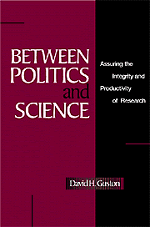Book contents
- Frontmatter
- Contents
- Tables and Figures
- Abbreviations
- Preface
- Introduction: Making Space for Science Policy
- Chapter 1 Science Policy: Structure and Boundaries
- Chapter 2 Understanding the Social Contract for Science
- Chapter 3 Challenges to the Social Contract for Science
- Chapter 4 Assuring the Integrity of Research
- Chapter 5 Assuring the Productivity of Research
- Chapter 6 Between Politics and Science
- Notes
- References
- Index
Chapter 4 - Assuring the Integrity of Research
Published online by Cambridge University Press: 14 October 2009
- Frontmatter
- Contents
- Tables and Figures
- Abbreviations
- Preface
- Introduction: Making Space for Science Policy
- Chapter 1 Science Policy: Structure and Boundaries
- Chapter 2 Understanding the Social Contract for Science
- Chapter 3 Challenges to the Social Contract for Science
- Chapter 4 Assuring the Integrity of Research
- Chapter 5 Assuring the Productivity of Research
- Chapter 6 Between Politics and Science
- Notes
- References
- Index
Summary
[A]t some point a misconduct in science case came to my attention, and I said, ‘How did we handle these kind of cases?’ And I am told that if the Director of NIH at the time or back in history felt that someone had really engaged in it, that he made a phone call or two, and that person disappeared from the map of science. I don't know whether it actually happened or who he called and what the process was, and clearly that was not, even if it was true, it was not an acceptable way to proceed.
– Richard Riseberg, Chief Counsel, Public Health Service (PHS 1991: 84).Introduction
Under the social contract for science, the management of scientific integrity was highly informal and contained entirely within the scientific community, as Richard Riseberg avers. The period “back in history” to which he refers is the time when James Shannon was still director of the National Institutes of Health (NIH), a golden age of the funding increases that Representative Fountain vigorously questioned but never really staunched. Scientists recall it rosily, for it lacked the intrusiveness of the rules and regulations, assurances, and certifications now familiar in every academic and government laboratory.
Yet it is also clear this informality was not an appropriate modus operandi. There was no notice of what constituted misconduct, no procedures for how misconduct was to be determined if charged, and no code of how it was to be punished if determined. Such action was seemingly as secret and precipitous as that protested by John Edsall during the anti-Communist hysteria.
- Type
- Chapter
- Information
- Between Politics and ScienceAssuring the Integrity and Productivity of Reseach, pp. 86 - 112Publisher: Cambridge University PressPrint publication year: 2000
- 1
- Cited by

